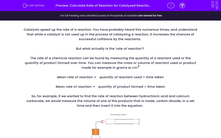Catalysts speed up the rate of a reaction. You have probably heard this numerous times, and understand that while a catalyst is not used up in the process of catalysing a reaction, it increases the chances of successful collisions by the reactants.
But what actually is the 'rate of reaction'?
The rate of a chemical reaction can be found by measuring the quantity of a reactant used or the quantity of product formed over time. You can measure the mass or volume of reactant used or product made for example in grams or cm3
Mean rate of reaction = quantity of reactant used ÷ time taken
Mean rate of reaction = quantity of product formed ÷ time taken
So, for example, if we wanted to find the rate of reaction between hydrochloric acid and calcium carbonate, we would measure the volume of one of the products that is made, carbon dioxide, in a set time and then insert it into the equation.

Volume of gas collected in 5 seconds = 45 cm3
Rate of reaction = 45 ÷ 5 = 9 cm3/s
So, then the same experiment was carried out but with the addition of a catalyst called manganese(IV) oxide, and this time 105 cm3 of carbon dioxide was produced in 3 seconds. Putting this into the rate of reaction equation again we see that:
Rate of reaction = 105 ÷ 3 = 35 cm3/s
This allows us to then directly compare the rate of reaction when a catalyst is used and when it isn't, and we can see that the rate of reaction is considerably higher in the catalysed reaction than the uncatalysed reaction.
Think you could calculate the rate of reaction? Let's have a go!
.jpg)







